Simulation-Based Prediction of Office Buildings Energy Performance Under RCP Scenarios Across All U.S. Climate Zones
Abstract
1. Introduction
2. Literature Review
2.1. Impact of Climate Change on Building Energy Demand
2.2. Energy Efficiency Strategies and Mitigation Measures
2.3. Simulation and Predictive Models
2.4. Challenges and Future Research Directions
3. Methodology
4. Overview of Simulations and Baseline EUI
4.1. Small Office Prototype Results
4.1.1. Changes by 2050
4.1.2. Changes by 2080
4.2. Medium Office Prototype Results
4.2.1. Changes by 2050
4.2.2. Changes by 2080
4.3. Large Office Prototype Results
4.3.1. Changes by 2050
4.3.2. Changes by 2080
4.4. Cross-Comparison by Climate Zone
4.5. Comparative Analysis Among Office Types
5. Discussion
Summary of Discussion
6. Conclusions
Directions for Future Research
Author Contributions
Funding
Institutional Review Board Statement
Informed Consent Statement
Data Availability Statement
Conflicts of Interest
Abbreviations
| EUI | Energy Use Intensity |
| RCP | Representative Concentration Pathways |
| ASHRAE | American Society of Heating, Refrigerating and Air-Conditioning Engineers |
| CFD | Computational Fluid Dynamics |
| UHI | Urban Heat Island |
| NZEB | Net-Zero Energy Building |
| PCMs | Phase Change Materials |
| PV | Photovoltaic |
References
- Li, Y.; Han, M.; Liu, S.; Chen, G. Energy consumption and greenhouse gas emissions by buildings: A multi-scale perspective. Build. Environ. 2019, 151, 240–250. [Google Scholar] [CrossRef]
- Min, J.; Yan, G.; Abed, A.M.; Elattar, S.; Khadimallah, M.A.; Jan, A.; Ali, H.E. The effect of carbon dioxide emissions on the building energy efficiency. Fuel 2022, 326, 124842. [Google Scholar] [CrossRef]
- Baglivo, C.; Albanese, P.M.; Congedo, P.M. Relationship between shape and energy performance of buildings under long-term climate change. J. Build. Eng. 2024, 84, 108544. [Google Scholar] [CrossRef]
- Wang, C.; Song, J.; Shi, D.; Reyna, J.L.; Horsey, H.; Feron, S.; Zhou, Y.; Ouyang, Z.; Li, Y.; Jackson, R.B. Impacts of climate change, population growth, and power sector decarbonization on urban building energy use. Nat. Commun. 2023, 14, 6434. [Google Scholar] [CrossRef] [PubMed]
- Ciancio, V.; Salata, F.; Falasca, S.; Curci, G.; Golasi, I.; de Wilde, P. Energy demands of buildings in the framework of climate change: An investigation across Europe. Sustain. Cities Soc. 2020, 60, 102213. [Google Scholar] [CrossRef]
- Chen, Y.; Ren, Z.; Peng, Z.; Yang, J.; Chen, Z.; Deng, Z. Impacts of climate change and building energy efficiency improvement on city-scale building energy consumption. J. Build. Eng. 2023, 78, 107646. [Google Scholar] [CrossRef]
- De Masi, R.F.; Gigante, A.; Ruggiero, S.; Russo, A. Impacts of the 4.5 and 8.5 RCP global climate scenarios on nearly zero energy building performance: Sensitivity analysis about operative conditions of insulation materials and PV system degradation. Sci. Technol. Built Environ. 2024, 30, 1236–1255. [Google Scholar] [CrossRef]
- Cody, B.; Loeschnig, W.; Eberl, A. Operating energy demand of various residential building typologies in different European climates. Smart Sustain. Built Environ. 2018, 7, 226–250. [Google Scholar] [CrossRef]
- Azar, E.; Menassa, C. Sensitivity of energy simulation models to occupancy related parameters in commercial buildings. In Proceedings of the Construction Research Congress 2012: Construction Challenges in a Flat World, West Lafayette, IN, USA, 21–23 May 2012; pp. 1381–1390. [Google Scholar]
- Dirks, J.A.; Gorrissen, W.J.; Hathaway, J.H.; Skorski, D.C.; Scott, M.J.; Pulsipher, T.C.; Huang, M.; Liu, Y.; Rice, J.S. Impacts of climate change on energy consumption and peak demand in buildings: A detailed regional approach. Energy 2015, 79, 20–32. [Google Scholar] [CrossRef]
- Huang, J.; Gurney, K.R. The variation of climate change impact on building energy consumption to building type and spatiotemporal scale. Energy 2016, 111, 137–153. [Google Scholar] [CrossRef]
- Alhindawi, I.; Jimenez-Bescos, C. Assessing the performance gap of climate change on buildings design analytical stages using future weather projections. Environ. Clim. Technol. 2020, 24, 119–134. [Google Scholar] [CrossRef]
- Apostolopoulou, A.; Jimenez-Bescos, C.; Cavazzi, S.; Boyd, D. Impact of Climate Change on the Heating Demand of Buildings. A District Level Approach. Environ. Clim. Technol. 2023, 27, 1–12. [Google Scholar]
- Behrens, P.; Van Vliet, M.T.; Nanninga, T.; Walsh, B.; Rodrigues, J.F. Climate change and the vulnerability of electricity generation to water stress in the European Union. Nat. Energy 2017, 2, 17114. [Google Scholar] [CrossRef]
- Chidiac, S.E.; Yao, L.; Liu, P. Climate change effects on heating and cooling demands of buildings in Canada. CivilEng 2022, 3, 277–295. [Google Scholar] [CrossRef]
- Meinshausen, M.; Smith, S.J.; Calvin, K.; Daniel, J.S.; Kainuma, M.L.; Lamarque, J.-F.; Matsumoto, K.; Montzka, S.A.; Raper, S.C.; Riahi, K. The RCP greenhouse gas concentrations and their extensions from 1765 to 2300. Clim. Change 2011, 109, 213–241. [Google Scholar] [CrossRef]
- Riahi, K.; Rao, S.; Krey, V.; Cho, C.; Chirkov, V.; Fischer, G.; Kindermann, G.; Nakicenovic, N.; Rafaj, P. RCP 8.5—A scenario of comparatively high greenhouse gas emissions. Clim. Change 2011, 109, 33–57. [Google Scholar] [CrossRef]
- Santamouris, M.; Vasilakopoulou, K. Present and future energy consumption of buildings: Challenges and opportunities towards decarbonisation. E-Prime-Adv. Electr. Eng. Electron. Energy 2021, 1, 100002. [Google Scholar] [CrossRef]
- Bell, N.O.; Bilbao, J.I.; Kay, M.; Sproul, A.B. Future climate scenarios and their impact on heating, ventilation and air-conditioning system design and performance for commercial buildings for 2050. Renew. Sustain. Energy Rev. 2022, 162, 112363. [Google Scholar] [CrossRef]
- Berardi, U.; Jafarpur, P. Assessing the impact of climate change on building heating and cooling energy demand in Canada. Renew. Sustain. Energy Rev. 2020, 121, 109681. [Google Scholar] [CrossRef]
- Chow, D.H.; Levermore, G.J. The effects of future climate change on heating and cooling demands in office buildings in the UK. Build. Serv. Eng. Res. Technol. 2010, 31, 307–323. [Google Scholar] [CrossRef]
- Ortiz, L.; González, J.E.; Lin, W. Climate change impacts on peak building cooling energy demand in a coastal megacity. Environ. Res. Lett. 2018, 13, 094008. [Google Scholar] [CrossRef]
- Baba, F.M.; Ge, H. Effect of climate change on the annual energy consumption of a single family house in British Columbia. In MATEC Web of Conferences; EDP Sciences: Les Ulis, France, 2018. [Google Scholar]
- Baba, F.M.; Ge, H. Effect of climate change on the energy performance and thermal comfort of high-rise residential buildings in cold climates. In MATEC Web of Conferences; EDP Sciences: Les Ulis, France, 2019. [Google Scholar]
- Xiaoxu, L.; Kailiang, H.; Guohui, F.; Danyang, J.; Dan, L.; Jiawei, L. Analysis on night ventilation effect of buildings with different energy consumption levels in Shenyang. In E3S Web of Conferences; EDP Sciences: Les Ulis, France, 2022. [Google Scholar]
- Spinoni, J.; Vogt, J.V.; Barbosa, P.; Dosio, A.; McCormick, N.; Bigano, A.; Füssel, H.-M. Changes of heating and cooling degree-days in Europe from 1981 to 2100. Int. J. Clim. 2018, 38, e191–e208. [Google Scholar] [CrossRef]
- Bass, B.; New, J. How will United States commercial building energy use be impacted by IPCC climate scenarios? Energy 2023, 263, 125945. [Google Scholar] [CrossRef]
- Geissler, S.; Österreicher, D.; Macharm, E. Transition towards energy efficiency: Developing the Nigerian building energy efficiency code. Sustainability 2018, 10, 2620. [Google Scholar] [CrossRef]
- San José, R.; Pérez, J.L.; Pérez, L.; Barras, R.M.G. Climate Change Impacts on Energy Demand of Madrid Buildings. J. Clean Energy Technol. 2018, 6, 87–92. [Google Scholar] [CrossRef]
- Khourchid, A.M.; Ajjur, S.B.; Al-Ghamdi, S.G. Building cooling requirements under climate change scenarios: Impact, mitigation strategies, and future directions. Buildings 2022, 12, 1519. [Google Scholar] [CrossRef]
- Wang, L.; Liu, X.; Brown, H. Prediction of the impacts of climate change on energy consumption for a medium-size office building with two climate models. Energy Build. 2017, 157, 218–226. [Google Scholar] [CrossRef]
- Altan, H. Energy efficiency interventions in UK higher education institutions. Energy Policy 2010, 38, 7722–7731. [Google Scholar] [CrossRef]
- Santos, P.; Gervásio, H.; da Silva, L.S.; Lopes, A.G. Influence of climate change on the energy efficiency of light-weight steel residential buildings. Civ. Eng. Environ. Syst. 2011, 28, 325–352. [Google Scholar] [CrossRef]
- Haghani, M.; Mohammadkari, B.; Fayaz, R. The Evaluation of a New Daylighting System’s Energy Performance: Reversible Daylighting System (RDS). arXiv 2023, arXiv:2303.07511. [Google Scholar]
- Österreicher, D.; Seerig, A. Buildings in Hot Climate Zones—Quantification of Energy and CO2 Reduction Potential for Different Architecture and Building Services Measures. Sustainability 2024, 16, 9812. [Google Scholar] [CrossRef]
- Karmann, C.; Schiavon, S.; Bauman, F. Thermal comfort in buildings using radiant vs. all-air systems: A critical literature review. Build. Environ. 2017, 111, 123–131. [Google Scholar] [CrossRef]
- Niknia, S.; Rashed-Ali, H. Analyzing energy consumption due to occupant interaction with manual and automatic window blinds in multiple climates. J. Build. Eng. 2024, 90, 109506. [Google Scholar] [CrossRef]
- Udendhran, R.; Sasikala, R.; Nishanthi, R.; Vasanthi, J. Smart Energy Consumption Control in Commercial Buildings Using Machine Learning and IOT. In E3S Web of Conferences; EDP Sciences: Les Ulis, France, 2023. [Google Scholar]
- Jenkins, D.P.; Patidar, S.; Simpson, S.A. Quantifying change in buildings in a future climate and their effect on energy systems. Buildings 2015, 5, 985–1002. [Google Scholar] [CrossRef]
- Leslie, P.; Pearce, J.M.; Harrap, R.; Daniel, S. The application of smartphone technology to economic and environmental analysis of building energy conservation strategies. Int. J. Sustain. Energy 2012, 31, 295–311. [Google Scholar] [CrossRef]
- Nimlyat, P.; Dassah, E.; Allu, E. Computer Simulations in Buildings: Implications for Building Energy Performance. IOSR J. Eng. 2014, 4, 56–62. [Google Scholar]
- Duan, Z.; de Wilde, P.; Attia, S.; Zuo, J. Challenges in predicting the impact of climate change on thermal building performance through simulation: A systematic review. Appl. Energy 2025, 382, 125331. [Google Scholar] [CrossRef]
- Kneifel, J.; Kneifel, J.; O’Rear, E. Benefits and Costs of Energy Standard Adoption for New Residential Buildings: National Summary; US Department of Commerce, National Institute of Standards and Technology: Gaithersburg, MD, USA, 2015. [Google Scholar]
- Ma, L.; Zeng, Z. A Survey of the Influence of Air Distribution on Indoor Environment and Building Energy Efficiency. J. Phys. Conf. Ser. 2022, 2287, 012041. [Google Scholar] [CrossRef]
- Billanes, J.D.; Ma, Z.G.; Jørgensen, B.N. Data-Driven Technologies for Energy Optimization in Smart Buildings: A Scoping Review. Energies 2025, 18, 290. [Google Scholar] [CrossRef]
- Elnagar, E.; Gendebien, S.; Georges, E.; Berardi, U.; Doutreloup, S.; Lemort, V. Framework to assess climate change impact on heating and cooling energy demands in building stock: A case study of Belgium in 2050 and 2100. Energy Build. 2023, 298, 113547. [Google Scholar] [CrossRef]
- Yau, Y.H.; Hasbi, S. A review of climate change impacts on commercial buildings and their technical services in the tropics. Renew. Sustain. Energy Rev. 2013, 18, 430–441. [Google Scholar] [CrossRef]
- Shang, Y.; Sang, S.; Tiwari, A.K.; Khan, S.; Zhao, X. Impacts of renewable energy on climate risk: A global perspective for energy transition in a climate adaptation framework. Appl. Energy 2024, 362, 122994. [Google Scholar] [CrossRef]
- Robert, A.; Kummert, M. Designing net-zero energy buildings for the future climate, not for the past. Build. Environ. 2012, 55, 150–158. [Google Scholar] [CrossRef]
- Ibrahim, M.; Harkouss, F.; Biwole, P.; Fardoun, F.; Oultboukhtine, S. Building retrofitting towards net zero energy under climate change. J. Phys. Conf. Ser. 2024, 2857, 012026. [Google Scholar] [CrossRef]
- Baniya, B.; Giurco, D. Net zero energy buildings and climate resilience narratives–Navigating the interplay in the building asset maintenance and management. Energy Rep. 2025, 13, 1632–1648. [Google Scholar] [CrossRef]
- U.S. Department of Energy (DOE). DOE Reference Commercial Buildings Report; Prototype Building Model Package. 2020. Available online: https://www.energycodes.gov/development/commercial/prototype_models (accessed on 7 April 2023).
- Jubb, I.; Canadell, P.; Dix, M. Representative Concentration Pathways (RCPs); Australian Government, Department of the Environment: Canberra, Australia, 2013. [Google Scholar]
- Athalye, R.; Halverson, M.; Rosenberg, M.; Liu, B.; Zhang, J.; Hart, R.; Mendon, V.; Goel, S.; Chen, Y.; Xie, Y. Energy Savings Analysis: ANSI/ASHRAE/IES Standard 90.1–2016; Pacific Northwest National Laboratory (PNNL): Richland, WA, USA, 2017. [Google Scholar]
- Meteotest. Meteonorm Software. 2023. Available online: https://meteonorm.com/en/ (accessed on 24 September 2023).
- PortfolioManager. U.S. Energy Use Intensity by Property Type. 2024. Available online: https://portfoliomanager.energystar.gov/pdf/reference/US%20National%20Median%20Table.pdf (accessed on 5 January 2025).
- Escandón, R.; Calama-González, C.M.; Alonso, A.; Suárez, R.; León-Rodríguez, Á.L. How do different methods for generating future weather data affect building performance simulations? A comparative analysis of Southern Europe. Buildings 2023, 13, 2385. [Google Scholar] [CrossRef]
- Pham, M.-H.; Phap, V.M.; Trung, N.N.; Son, T.T.; Kien, D.T.; Anh Tho, V.T. A study on the impact of various meteorological data on the design performance of rooftop solar power projects in vietnam: A case study of electric power university. Energies 2022, 15, 7149. [Google Scholar] [CrossRef]
- Isaac, M.; Van Vuuren, D.P. Modeling global residential sector energy demand for heating and air conditioning in the context of climate change. Energy Policy 2009, 37, 507–521. [Google Scholar] [CrossRef]
- Santamouris, M. On the energy impact of urban heat island and global warming on buildings. Energy Build. 2014, 82, 100–113. [Google Scholar] [CrossRef]
- Brozovsky, J.; Radivojevic, J.; Simonsen, A. Assessing the impact of urban microclimate on building energy demand by coupling CFD and building performance simulation. J. Build. Eng. 2022, 55, 104681. [Google Scholar] [CrossRef]
- Wang, H.; Chen, Q. Impact of climate change heating and cooling energy use in buildings in the United States. Energy Build. 2014, 82, 428–436. [Google Scholar] [CrossRef]
- Choi, J.-H.; Loftness, V.; Aziz, A. Post-occupancy evaluation of 20 office buildings as basis for future IEQ standards and guidelines. Energy Build. 2012, 46, 167–175. [Google Scholar] [CrossRef]
- Santamouris, M.; Ding, L.; Fiorito, F.; Oldfield, P.; Osmond, P.; Paolini, R.; Prasad, D.; Synnefa, A. Passive and active cooling for the outdoor built environment–Analysis and assessment of the cooling potential of mitigation technologies using performance data from 220 large scale projects. Sol. Energy 2017, 154, 14–33. [Google Scholar] [CrossRef]
- Crawley, D.B. Estimating the impacts of climate change and urbanization on building performance. J. Build. Perform. Simul. 2008, 1, 91–115. [Google Scholar] [CrossRef]
- Attia, S.; Evrard, A.; Gratia, E. Development of benchmark models for the Egyptian residential buildings sector. Appl. Energy 2012, 94, 270–284. [Google Scholar] [CrossRef]
- Moradinia, S.F.; Hussein, A.R.; Chan, M.; Bagherifam, N.; Baghalzadeh Shishehgarkhaneh, M. Evaluating the Impact of Phase Change Materials and Double-Skin Façades on Energy Performance in Office Buildings under Climate Change Scenarios: A Case Study in Iran. Eng 2024, 5, 3049–3079. [Google Scholar] [CrossRef]
- Reddy, V.J.; Hariram, N.; Ghazali, M.F.; Kumarasamy, S. Pathway to sustainability: An overview of renewable energy integration in building systems. Sustainability 2024, 16, 638. [Google Scholar] [CrossRef]
- Fajilla, G.; De Simone, M.; Cabeza, L.F.; Bragança, L. Assessment of the impact of occupants’ behavior and climate change on heating and cooling energy needs of buildings. Energies 2020, 13, 6468. [Google Scholar] [CrossRef]
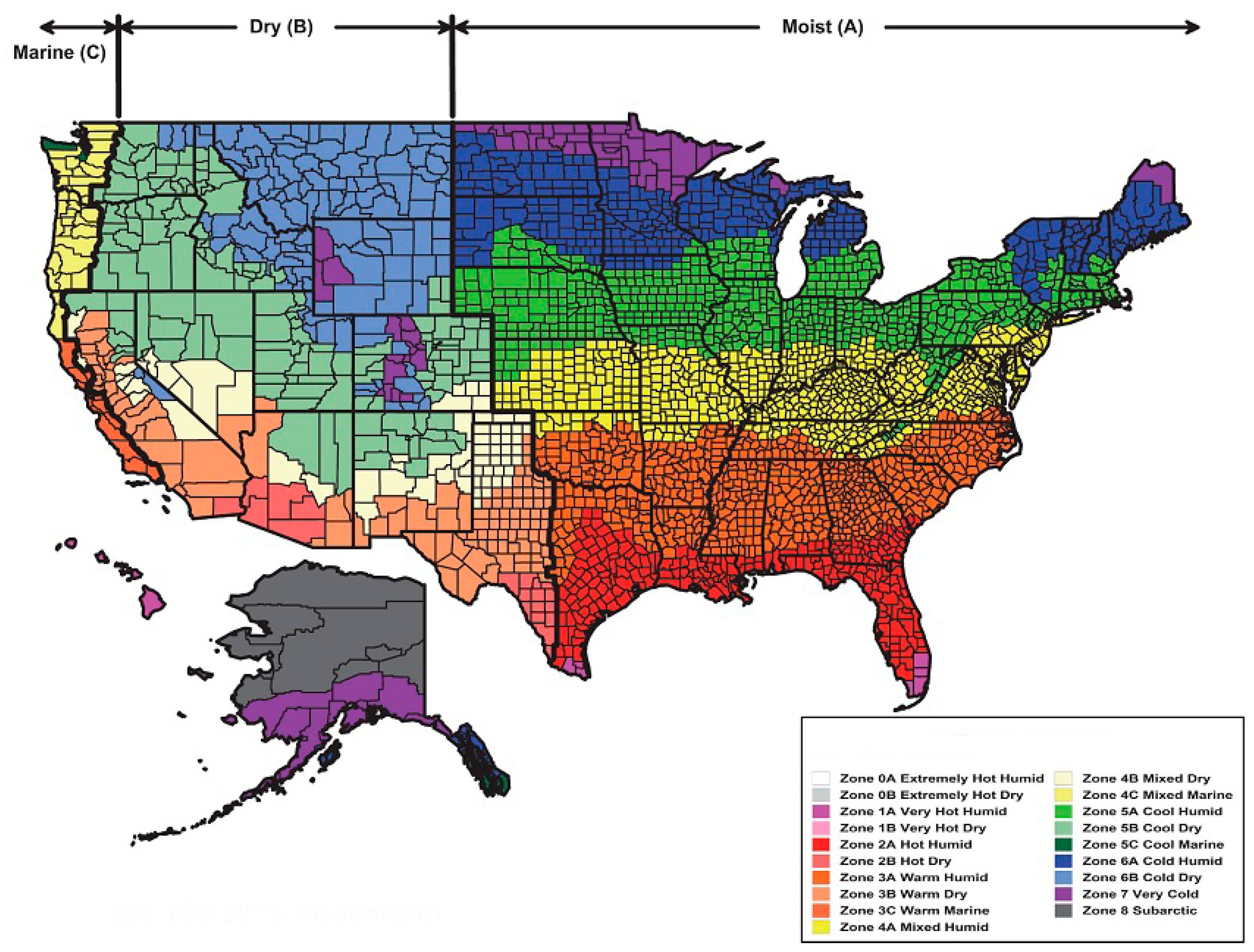


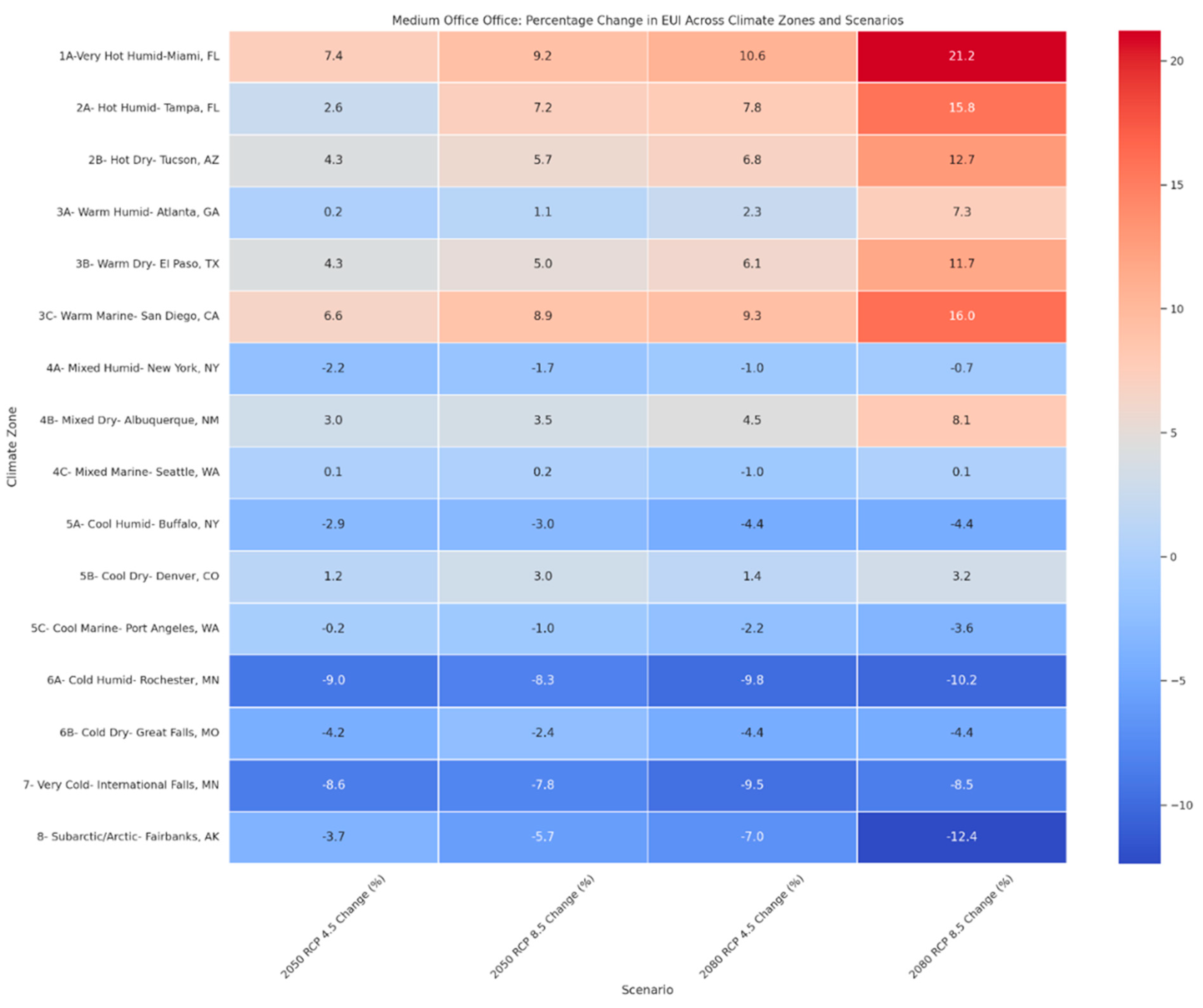

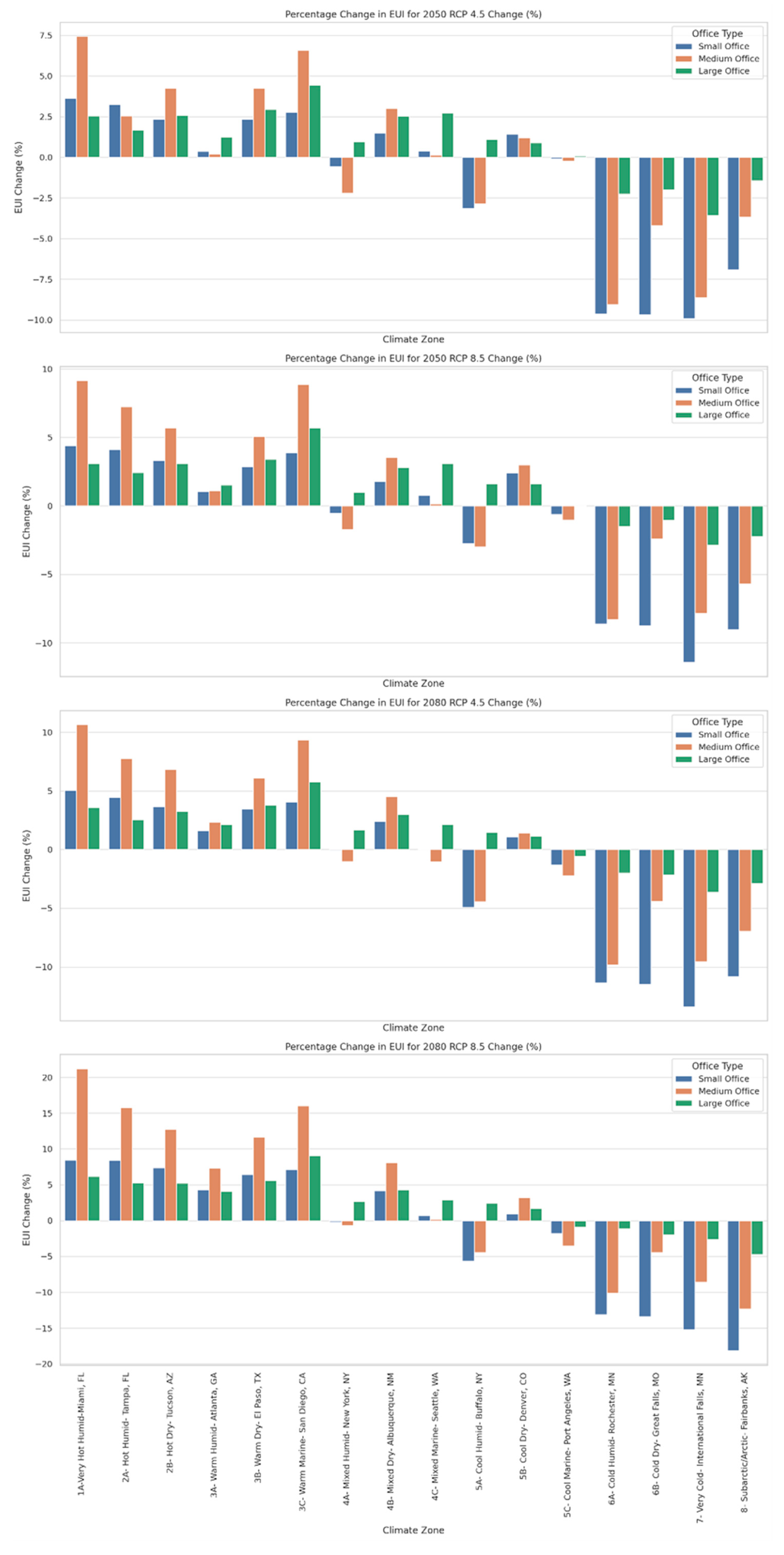

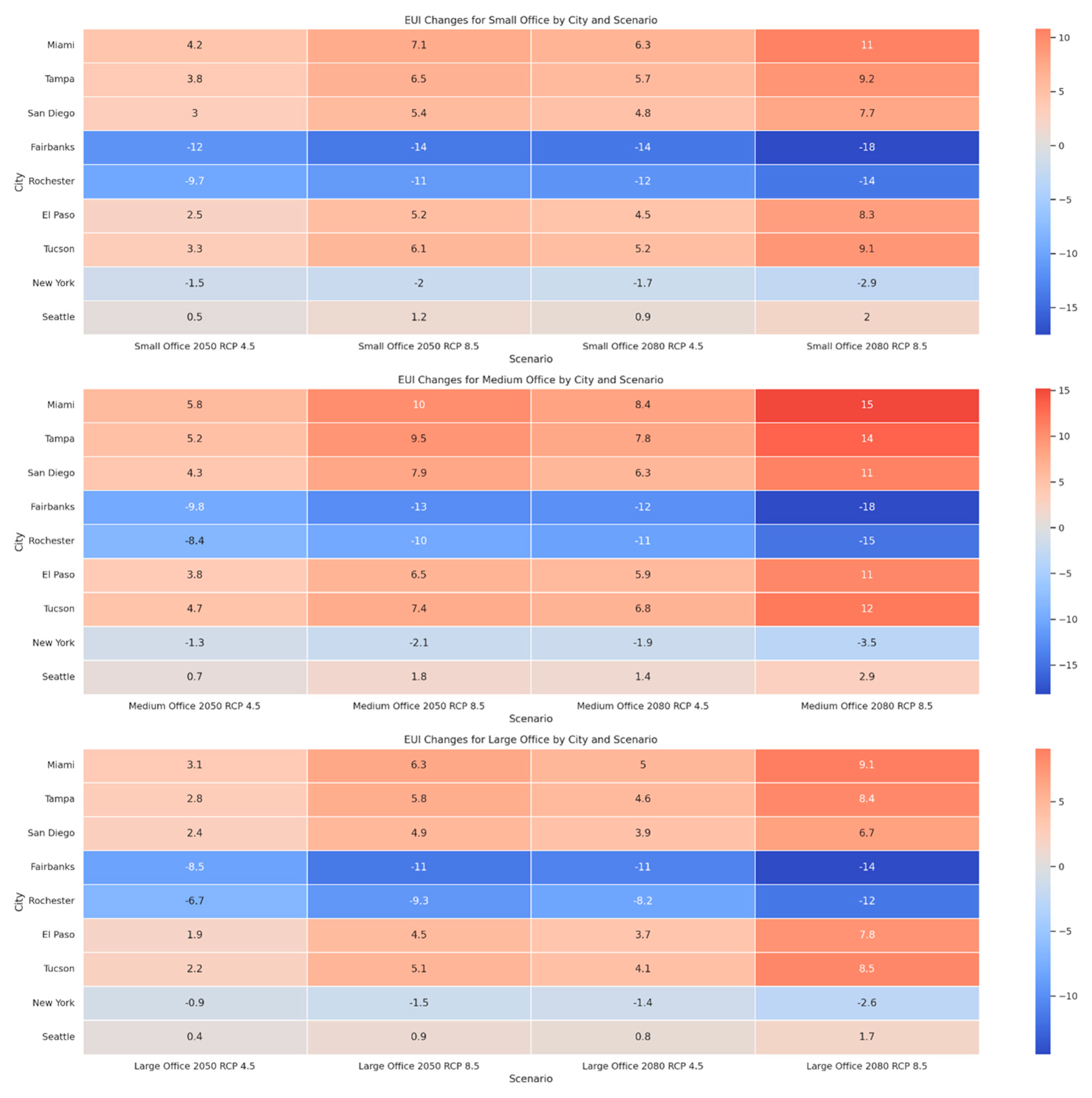

| Building Prototype | Small Office | Medium Office | Large Office | |
|---|---|---|---|---|
| Building shape |  |  | 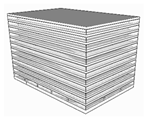 | |
| Number of Floors | 1 | 3 | 12 (plus basement) | |
| Window Fraction (Window-to-Wall Ratio) | 21.2% | 33.0% | 38.1% | |
| Exterior walls Construction * | Above-Grade Wall Type | Wood-frame walls (2 × 4@ 16 in o.c.) 1in. Stucco + 5/8 in. gypsum board + wall Insulation + 5/8 in. gypsum board | Steel-Frame Walls (2 × 4 @16 in o.c) 0.4 in. Stucco + 5/8 in. gypsum board + wall Insulation + 5/8 in. | Mass (pre-cast concrete panel) 8 in. heavy-weight concrete + wall insulation + 0.5 in. gypsum board |
| Associated Space Conditioning Category | Nonresidential | Nonresidential | Nonresidential | |
| Roof Construction * | Roof Type | Attic roof with wood joist: Roof insulation + 5/8 in. gypsum board | Built-up roof: Roof membrane + roof insulation + metal decking | Built-up roof: Roof membrane + roof insulation + metal decking |
| Associated Space Conditioning Category | Nonresidential | Nonresidential | Nonresidential | |
| CLIMATE ZONE | CURRENT | 2050 | 2080 | ||
|---|---|---|---|---|---|
| RCP 4.5 EUI (kBtu/f2) * | RCP 8.5 EUI (kBtu/f2) * | RCP 4.5 EUI (kBtu/f2) * | RCP 8.5 EUI (kBtu/f2) * | ||
| 1A-Very Hot Humid-Miami, FL | 27.5 | 28.5 | 28.71 | 28.89 | 29.83 |
| 2A-Hot Humid-Tampa, FL | 26.38 | 27.24 | 27.47 | 27.55 | 28.6 |
| 2B-Hot Dry-Tucson, AZ | 26.03 | 26.64 | 26.89 | 26.98 | 27.95 |
| 3A-Warm Humid-Atlanta, GA | 24.65 | 24.74 | 24.91 | 25.05 | 25.7 |
| 3B-Warm Dry-El Paso, TX | 24.78 | 25.36 | 25.49 | 25.64 | 26.37 |
| 3C-Warm Marine-San Diego, CA | 22.35 | 22.97 | 23.22 | 23.25 | 23.95 |
| 4A-Mixed Humid-New York, NY | 24.66 | 24.52 | 24.53 | 24.64 | 24.61 |
| 4B-Mixed Dry-Albuquerque, NM | 24.44 | 24.81 | 24.88 | 25.03 | 25.45 |
| 4C-Mixed Marine-Seattle, WA | 22.64 | 22.73 | 22.82 | 22.65 | 22.79 |
| 5A-Cool Humid-Buffalo, NY | 26.48 | 25.65 | 25.75 | 25.18 | 24.99 |
| 5B-Cool Dry-Denver, CO | 24.72 | 25.07 | 25.31 | 24.99 | 24.94 |
| 5C-Cool Marine-Port Angeles, WA | 22.61 | 22.59 | 22.47 | 22.31 | 22.2 |
| 6A-Cold Humid-Rochester, MN | 31.48 | 28.45 | 28.77 | 27.9 | 27.35 |
| 6B-Cold Dry-Great Falls, MT | 31.55 | 28.5 | 28.79 | 27.93 | 27.32 |
| 7-Very Cold-International Falls, MN | 34.77 | 31.33 | 30.8 | 30.12 | 29.49 |
| 8-Subarctic/Arctic-Fairbanks, AK | 42.81 | 39.85 | 38.94 | 38.18 | 35.03 |
| CLIMATE ZONE | CURRENT | 2050 | 2080 | ||
|---|---|---|---|---|---|
| RCP 4.5 EUI(kBtu/f2) * | RCP 8.5 EUI(kBtu/f2) * | RCP 4.5 EUI(kBtu/f2) * | RCP 8.5 EUI(kBtu/f2) * | ||
| 1A-Very Hot Humid-Miami, FL | 29.69 | 31.9 | 32.41 | 32.85 | 35.99 |
| 2A-Hot Humid-Tampa, FL | 27.77 | 28.48 | 29.78 | 29.93 | 32.15 |
| 2B-Hot Dry-Tucson, AZ | 26.76 | 27.9 | 28.28 | 28.59 | 30.17 |
| 3A-Warm Humid-Atlanta, GA | 26.34 | 26.4 | 26.63 | 26.95 | 28.27 |
| 3B-Warm Dry-El Paso, TX | 25.36 | 26.44 | 26.64 | 26.91 | 28.32 |
| 3C-Warm Marine-San Diego, CA | 21.76 | 23.19 | 23.69 | 23.79 | 25.25 |
| 4A-Mixed Humid-New York, NY | 27.66 | 27.05 | 27.19 | 27.38 | 27.47 |
| 4B-Mixed Dry-Albuquerque, NM | 25.4 | 26.16 | 26.3 | 26.55 | 27.45 |
| 4C-Mixed Marine-Seattle, WA | 23.29 | 23.32 | 23.33 | 23.05 | 23.32 |
| 5A-Cool Humid-Buffalo, NY | 29.76 | 28.91 | 28.87 | 28.44 | 28.44 |
| 5B-Cool Dry-Denver, CO | 26.34 | 26.66 | 27.13 | 26.72 | 27.18 |
| 5C-Cool Marine-Port Angeles, WA | 23.28 | 23.23 | 23.04 | 22.76 | 22.45 |
| 6A-Cold Humid-Rochester, MN | 34.54 | 31.42 | 31.68 | 31.15 | 31.03 |
| 6B-Cold Dry-Great Falls, MT | 29.68 | 28.43 | 28.97 | 28.37 | 28.36 |
| 7-Very Cold-International Falls, MN | 29.6 | 27.05 | 27.28 | 26.78 | 27.07 |
| 8-Subarctic/Arctic-Fairbanks, AK | 33.91 | 32.66 | 31.98 | 31.55 | 29.72 |
| CLIMATE ZONE | CURRENT | 2050 | 2080 | ||
|---|---|---|---|---|---|
| RCP 4.5 EUI (kBtu/f2) * | RCP 8.5 EUI (kBtu/f2) * | RCP 4.5 EUI (kBtu/f2) * | RCP 8.5 EUI (kBtu/f2) * | ||
| 1A-Very Hot Humid-Miami, FL | 55.92 | 57.35 | 57.65 | 57.92 | 59.38 |
| 2A-Hot Humid-Tampa, FL | 52.43 | 53.32 | 53.71 | 53.77 | 55.18 |
| 2B-Hot Dry-Tucson, AZ | 53.27 | 54.65 | 54.92 | 55.01 | 56.06 |
| 3A-Warm Humid-Atlanta, GA | 50.19 | 50.82 | 50.96 | 51.26 | 52.25 |
| 3B-Warm Dry-El Paso, TX | 52.79 | 54.35 | 54.59 | 54.8 | 55.75 |
| 3C-Warm Marine-San Diego, CA | 46.19 | 48.24 | 48.82 | 48.85 | 50.38 |
| 4A-Mixed Humid-New York, NY | 49.31 | 49.79 | 49.8 | 50.14 | 50.63 |
| 4B-Mixed Dry-Albuquerque, NM | 52.63 | 53.97 | 54.1 | 54.21 | 54.88 |
| 4C-Mixed Marine-Seattle, WA | 45.53 | 46.78 | 46.94 | 46.51 | 46.85 |
| 5A-Cool Humid-Buffalo, NY | 49.07 | 49.61 | 49.86 | 49.78 | 50.26 |
| 5B-Cool Dry-Denver, CO | 52.66 | 53.13 | 53.51 | 53.26 | 53.55 |
| 5C-Cool Marine-Port Angeles, WA | 45.95 | 45.99 | 45.93 | 45.69 | 45.51 |
| 6A-Cold Humid-Rochester, MN | 52.46 | 51.28 | 51.68 | 51.41 | 51.85 |
| 6B-Cold Dry-Great Falls, MT | 55.32 | 54.22 | 54.74 | 54.13 | 54.21 |
| 7-Very Cold-International Falls, MN | 52.46 | 50.58 | 50.95 | 50.55 | 51.08 |
| 8-Subarctic/Arctic-Fairbanks, AK | 54.29 | 53.51 | 53.08 | 52.74 | 51.72 |
Disclaimer/Publisher’s Note: The statements, opinions and data contained in all publications are solely those of the individual author(s) and contributor(s) and not of MDPI and/or the editor(s). MDPI and/or the editor(s) disclaim responsibility for any injury to people or property resulting from any ideas, methods, instructions or products referred to in the content. |
© 2025 by the authors. Licensee MDPI, Basel, Switzerland. This article is an open access article distributed under the terms and conditions of the Creative Commons Attribution (CC BY) license (https://creativecommons.org/licenses/by/4.0/).
Share and Cite
Niknia, S.; Ghiai, M. Simulation-Based Prediction of Office Buildings Energy Performance Under RCP Scenarios Across All U.S. Climate Zones. Architecture 2025, 5, 34. https://doi.org/10.3390/architecture5020034
Niknia S, Ghiai M. Simulation-Based Prediction of Office Buildings Energy Performance Under RCP Scenarios Across All U.S. Climate Zones. Architecture. 2025; 5(2):34. https://doi.org/10.3390/architecture5020034
Chicago/Turabian StyleNiknia, Sepideh, and Mehdi Ghiai. 2025. "Simulation-Based Prediction of Office Buildings Energy Performance Under RCP Scenarios Across All U.S. Climate Zones" Architecture 5, no. 2: 34. https://doi.org/10.3390/architecture5020034
APA StyleNiknia, S., & Ghiai, M. (2025). Simulation-Based Prediction of Office Buildings Energy Performance Under RCP Scenarios Across All U.S. Climate Zones. Architecture, 5(2), 34. https://doi.org/10.3390/architecture5020034






